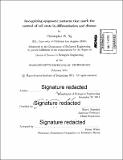| dc.contributor.advisor | Ernest Fraenkel. | en_US |
| dc.contributor.author | Ng, Christopher W | en_US |
| dc.contributor.other | Massachusetts Institute of Technology. Department of Biological Engineering. | en_US |
| dc.date.accessioned | 2015-07-31T19:10:35Z | |
| dc.date.available | 2015-07-31T19:10:35Z | |
| dc.date.copyright | 2015 | en_US |
| dc.date.issued | 2015 | en_US |
| dc.identifier.uri | http://hdl.handle.net/1721.1/97978 | |
| dc.description | Thesis: Sc. D., Massachusetts Institute of Technology, Department of Biological Engineering, 2015. | en_US |
| dc.description | Cataloged from PDF version of thesis. | en_US |
| dc.description | Includes bibliographical references (pages 157-192). | en_US |
| dc.description.abstract | Unlike the genomic sequence, the epigenome is dynamic, responding to and influencing the cellular state. Understanding the ways in which chromatin structure exercises control over transcriptional programs during development as well as aberrant gene expression signatures in human disease is a central challenge to biology and pathology. Despite the advance of tools to chart the chromatin landscape, much is still unknown about how epigenetic signals are integrated in the transcriptional outcome of a gene. Here, a number of systematic, genome-wide approaches result in the discovery of epigenetic patterns associated with the modulation of gene expression. We begin by examining Huntington's disease (HD), a fatal neurodegenerative disorder. The discovery of the genetic mutation that causes HD has led to the development of in-vitro and in-vivo models representative of the disease. Studies of these systems and patient samples have identified transcriptional dysregulation as a major component of the early stages of HD. Thus, HD serves as an ideal case in which to examine the modulation of gene expression in disease. First, we connect the changes in DNA methylation to the dynamics of gene expression and transcription factor binding in HD. We next identify a unique signature of the histone mark H3K4me3 at genes transcriptionally repressed in HD. Targeting this signature reverses the downregulation of genes and protects against neurodegeneration. Finally, we apply a novel, machine learning approach to 16 chromatin features in 44 human cell types. By globally examining the epigenetic states of genes in a variety of tissue contexts, we discover a small set of coordinated patterns that we term "epigenetic ensembles." Genes with particular ensembles are associated with changes in gene expression during differentiation and the control of cell-type-specific gene regulators such as super-enhancers, distal-enhancer-looping, nuclear lamina, and master transcription factors. Ensembles are also disproportionately affected in both HD and Alzheimer's disease. Together, this thesis presents a toolkit for recognizing and understanding epigenetic patterns that can further insight into the regulation of genes in development and disease. | en_US |
| dc.description.statementofresponsibility | by Christopher W. Ng. | en_US |
| dc.format.extent | 192 pages | en_US |
| dc.language.iso | eng | en_US |
| dc.publisher | Massachusetts Institute of Technology | en_US |
| dc.rights | MIT theses are protected by copyright. They may be viewed, downloaded, or printed from this source but further reproduction or distribution in any format is prohibited without written permission. | en_US |
| dc.rights.uri | http://dspace.mit.edu/handle/1721.1/7582 | en_US |
| dc.subject | Biological Engineering. | en_US |
| dc.title | Recognizing epigenetic patterns that mark the control of cell state in differentiation and disease | en_US |
| dc.type | Thesis | en_US |
| dc.description.degree | Sc. D. | en_US |
| dc.contributor.department | Massachusetts Institute of Technology. Department of Biological Engineering | |
| dc.identifier.oclc | 914167659 | en_US |
